Green Manuring Effect on Changes of Soil Nitrogen Fractions, Maize Growth, and Nutrient Uptake
Abstract
1. Introduction
2. Materials and Methods
2.1. Field Experiments
2.2. Sampling and Measurements
2.3. Statistical Analysis
3. Results
3.1. Effects of OV Incorporation on Maize Growth, Yield, and Nutrient Uptake
3.2. Temporal Changes of Soil N Fractions during Maize Growth as Influenced by Fertilizer Application and OV Incorporation
3.3. Interactions between Soil N Fractions and Maize Growth and Nutrient Uptake
4. Discussion
4.1. At Least 15–30% of Inorganic Fertilizer Input Could Be Reduced in the OV Incorporation-Based Maize Rotation
4.2. Integrated Management of OV Incorporation and Fertilizer Application Compensated for Soil N Pools
4.3. Temporal Changes of Soil N Pools Highlights Dominant Contribution of Dissolved Organic N and Mineral N to Maize N Uptake and Growth
5. Conclusions
Author Contributions
Funding
Acknowledgments
Conflicts of Interest
References
- Chen, X.; Cui, Z.; Fan, M.; Vitousek, P.; Zhao, M.; Ma, W.; Wang, Z.; Zhang, W.; Yan, X.; Yang, J.; et al. Producing more grain with lower environmental costs. Nature 2014, 514, 486. [Google Scholar] [CrossRef] [PubMed]
- Yu, W.; Elleby, C.; Zobbe, H. Food security policies in India and China: Implications for national and global food security. Food Secur. 2015, 7, 405–414. [Google Scholar] [CrossRef]
- Vitousek, P.M.; Naylor, R.; Crews, T.; David, M.B.; Drinkwater, L.E.; Holland, E.; Johnes, P.J.; Katzenberger, J.; Martinelli, L.A.; Matson, P.A.; et al. Nutrient imbalances in agricultural development. Science 2009, 324, 1519–1520. [Google Scholar] [CrossRef] [PubMed]
- Chen, X.P.; Cui, Z.L.; Vitousek, P.M.; Cassman, K.G.; Matson, P.A.; Bai, J.S.; Meng, Q.F.; Hou, P.; Yue, S.C.; Römheld, V.; et al. Integrated soil-crop system management for food security. Proc. Natl. Acad. Sci. USA 2011, 108, 6399–6404. [Google Scholar] [CrossRef] [PubMed]
- Meng, Q.; Hou, P.; Wu, L.; Chen, X.; Cui, Z.; Zhang, F. Understanding production potentials and yield gaps in intensive maize production in China. Field Crop Res. 2013, 143, 91–97. [Google Scholar] [CrossRef]
- Ju, X.T.; Xing, G.X.; Chen, X.P.; Zhang, S.L.; Zhang, L.J.; Liu, X.J.; Cui, Z.L.; Yin, B.; Christie, P.; Zhu, Z.L.; et al. Reducing environmental risk by improving N management in intensive Chinese agricultural systems. Proc. Natl. Acad. Sci. USA 2009, 106, 3041–3046. [Google Scholar] [CrossRef] [PubMed]
- Zhou, J.; Gu, B.; Schlesinger, W.H.; Ju, X. Significant accumulation of nitrate in Chinese semi-humid croplands. Sci. Rep. 2016, 6, 25088. [Google Scholar] [CrossRef] [PubMed]
- Zheng, X.; Han, S.; Huang, Y.; Wang, Y.; Wang, M. Re-quantifying the emission factors based on field measurements and estimating the direct N2O emission from Chinese croplands. Glob. Biogeochem. Cycles 2004, 18, GB2018. [Google Scholar] [CrossRef]
- Xie, Z.; Tu, S.; Shah, F.; Xu, C.; Chen, J.; Han, D.; Liu, G.; Li, H.; Muhammad, I.; Cao, W. Substitution of fertilizer-N by green manure improves the sustainability of yield in double-rice cropping system in south China. Field Crop Res. 2016, 188, 142–149. [Google Scholar] [CrossRef]
- Thorup-Kristensen, K.; Magid, J.; Jensen, L.S. Catch crops and green manures as biological tools in nitrogen management in temperate zones. Adv. Agron. 2003, 79, 227–302. [Google Scholar]
- Yang, L.; Cao, W.; Thorupkristensen, K.; Bai, J.; Gao, S.; Chang, D. Effect of Orychophragmus violaceus incorporation on nitrogen uptake in succeeding maize. Plant Soil Environ. 2015, 61, 260–265. [Google Scholar] [CrossRef]
- Bai, J.; Cao, W.; Xiong, J.; Zeng, N.; Gao, S.; Katsuyoshi, S. Integrated application of February Orchid (Orychophragmus violaceus) as green manure with chemical fertilizer for improving grain yield and reducing nitrogen losses in spring maize system in northern China. J. Integr. Agric. 2015, 14, 2490–2499. [Google Scholar] [CrossRef]
- Li, H.; Zheng, L.; Lei, Y.; Li, C.; Liu, Z.; Zhang, S. Estimation of water consumption and crop water productivity of winter wheat in North China Plain using remote sensing technology. Agric. Water Manag. 2008, 95, 1271–1278. [Google Scholar] [CrossRef]
- Thorup-Kristensen, K. Are differences in root growth of nitrogen catch crops important for their ability to reduce soil nitrate-N content, and how can this be measured? Plant Soil 2001, 230, 185–195. [Google Scholar] [CrossRef]
- Zhang, D.; Yao, P.; Na, Z.; Yu, C.; Cao, W.; Gao, Y. Contribution of green manure legumes to nitrogen dynamics in traditional winter wheat cropping system in the Loess Plateau of China. Eur. J. Agron. 2016, 72, 47–55. [Google Scholar]
- Yu, Y.; Xue, L.; Yang, L. Winter legumes in rice crop rotations reduces nitrogen loss, and improves rice yield and soil nitrogen supply. Agron. Sustain. Dev. 2014, 34, 633–640. [Google Scholar] [CrossRef]
- Hooker, K.V.; Coxon, C.E.; Hackett, R.; Kirwan, L.E.; O’Keeffe, E.; Richards, K.G. Evaluation of cover crop and reduced cultivation for reducing nitrate leaching in Ireland. J. Environ. Qual. 2008, 37, 138–145. [Google Scholar] [CrossRef] [PubMed]
- Zhou, Z.; Zhang, L.; Cao, W.; Huang, Y. Appraisal of agro-ecosystem services in winter green manure-spring maize. Ecol. Environ. Sci. 2016, 25, 597–604, (In Chinese with English Abstract). [Google Scholar]
- Mandal, U.K.; Singh, G.; Victor, U.S.; Sharma, K.L. Green manuring: Its effect on soil properties and crop growth under rice-wheat cropping system. Eur. J. Agron. 2003, 19, 225–237. [Google Scholar] [CrossRef]
- Zhang, F.; Cui, Z.; Chen, X.; Ju, X.; Shen, J.; Chen, Q.; Liu, X.; Zhang, W.; Mi, G.; Fan, M. Chapter one-Integrated nutrient management for food security and environmental quality in China. Adv. Agron. 2012, 116, 1–40. [Google Scholar]
- Glasener, K.M.; Wagger, M.G.; Mackown, C.T.; Volk, R.J. Contributions of shoot and root nitrogen-15 labeled legume nitrogen sources to a sequence of three cereal crops. Soil Sci. Soc. Am. J. 2002, 66, 523–530. [Google Scholar] [CrossRef]
- Kielland, K. Amino acid absorption by arctic plants: Implications for plant nutrition and nitrogen cycling. Ecology 1994, 75, 2373–2383. [Google Scholar] [CrossRef]
- Stark, C.; Condron, L.M.; Stewart, A. Influence of organic and mineral amendments on microbial soil properties and processes. Appl. Soil Ecol. 2007, 35, 79–93. [Google Scholar] [CrossRef]
- Wu, L.Q.; Wu, L.; Cui, Z.L.; Chen, X.P.; Zhang, F.S. Basic NPK fertilizer recommendation and fertilizer formula for maize production regions in China. Acta Pedol. Sin. 2015, 52, 802–817, (In Chinese with English Abstract). [Google Scholar]
- Liu, J.; Chen, X.; Zhang, J.; Xu, C.; Cao, W. Study on characteristics of decomposition and nutrients release of winter green manure crop Orychophragmus violaceus in North China. Chin. J. Grassl. 2013, 35, 58–63, (In Chinese with English Abstract). [Google Scholar]
- Nelson, D.W.; Sommers, L.E. Determination of total nitrogen in plant material. Agron. J. 1973, 65, 109–112. [Google Scholar] [CrossRef]
- Soon, Y.K.; Kalra, Y.P. A comparison of plant tissue digestion methods for nitrogen and phosphorus analyses. Can. J. Soil Sci. 1995, 75, 243–245. [Google Scholar] [CrossRef]
- Walker, J.M.; Barber, S.A. Absorption of potassium and rubidium from the soil by corn roots. Plant Soil 1962, 17, 243–259. [Google Scholar] [CrossRef]
- Bremner, J.M. Determination of nitrogen in soil by the Kjeldahl method. J. Agric. Sci. 1960, 55, 11–33. [Google Scholar] [CrossRef]
- Brookes, P.C.; Landman, A.; Pruden, G.; Jenkinson, D.S. Chloroform fumigation and the release of soil nitrogen: A rapid direct extraction method to measure microbial biomass nitrogen in soil. Soil Biol. Biochem. 1985, 17, 837–842. [Google Scholar] [CrossRef]
- Jones, D.L.; Willett, V.B. Experimental evaluation of methods to quantify dissolved organic nitrogen (DON) and dissolved organic carbon (DOC) in soil. Soil Biol. Biochem. 2006, 38, 991–999. [Google Scholar] [CrossRef]
- Kabacoff, R. R in Action: Data Analysis and Graphics with R.; Manning Publications Co.: Shelter Island, NY, USA, 2015. [Google Scholar]
- Sanchez, G. Plsdepot: Partial Least Squares (PLS) Data Analysis Methods v. 0.1.17. 2012. Available online: http://cran.r-project.org/web/packages/plsdepot/index.html (accessed on 9 September 2018).
- Gu, B.; Ju, X.; Chang, J.; Ge, Y.; Vitousek, P.M. Integrated reactive nitrogen budgets and future trends in china. Proc. Natl. Acad. Sci. USA 2015, 112, 8792. [Google Scholar] [CrossRef] [PubMed]
- Tosti, G.; Benincasa, P.; Farneselli, M.; Pace, R.; Tei, F.; Guiducci, M.; Thorup-Kristensen, K. Green manuring effect of pure and mixed barley-hairy vetch winter cover crops on maize and processing tomato N nutrition. Eur. J. Agron. 2012, 43, 136–146. [Google Scholar] [CrossRef]
- Liang, B.; Yang, X.; He, X.; Zhou, J. Effects of 17-year fertilization on soil microbial biomass C and N and soluble organic C and N in Loessial soil during maize growth. Biol. Fertil. Soils 2011, 47, 121–128. [Google Scholar] [CrossRef]
- Kumar, K.; Goh, K.M. Crop Residues and Management Practices: Effects on Soil Quality, Soil Nitrogen Dynamics, Crop Yield, and Nitrogen Recovery. Adv. Agron. 2000, 68, 197–319. [Google Scholar]
- Streeter, T.C.; Bol, R.; Bardgett, R.D. Amino acids as a nitrogen source in temperate upland grasslands: The use of dual labelled (13C, 15N) glycine to test for direct uptake by dominant grasses. Rapid Commun. Mass Spectrom. 2015, 14, 1351–1355. [Google Scholar] [CrossRef]
- Jones, D.L.; Darrah, P.R. Amino-acid influx at the soil-root interface of Zea mays L. and its implications in the rhizosphere. Plant Soil 1994, 163, 1–12. [Google Scholar] [CrossRef]
- Yu, Z.S.; Northup, R.R.; Dahlgren, R.A. Determination of dissolved organic nitrogen using persulfate oxidation and conductimetric quantification of nitrate-nitrogen. Commun. Soil Sci. Plant Anal. 1994, 25, 3161–3169. [Google Scholar] [CrossRef]
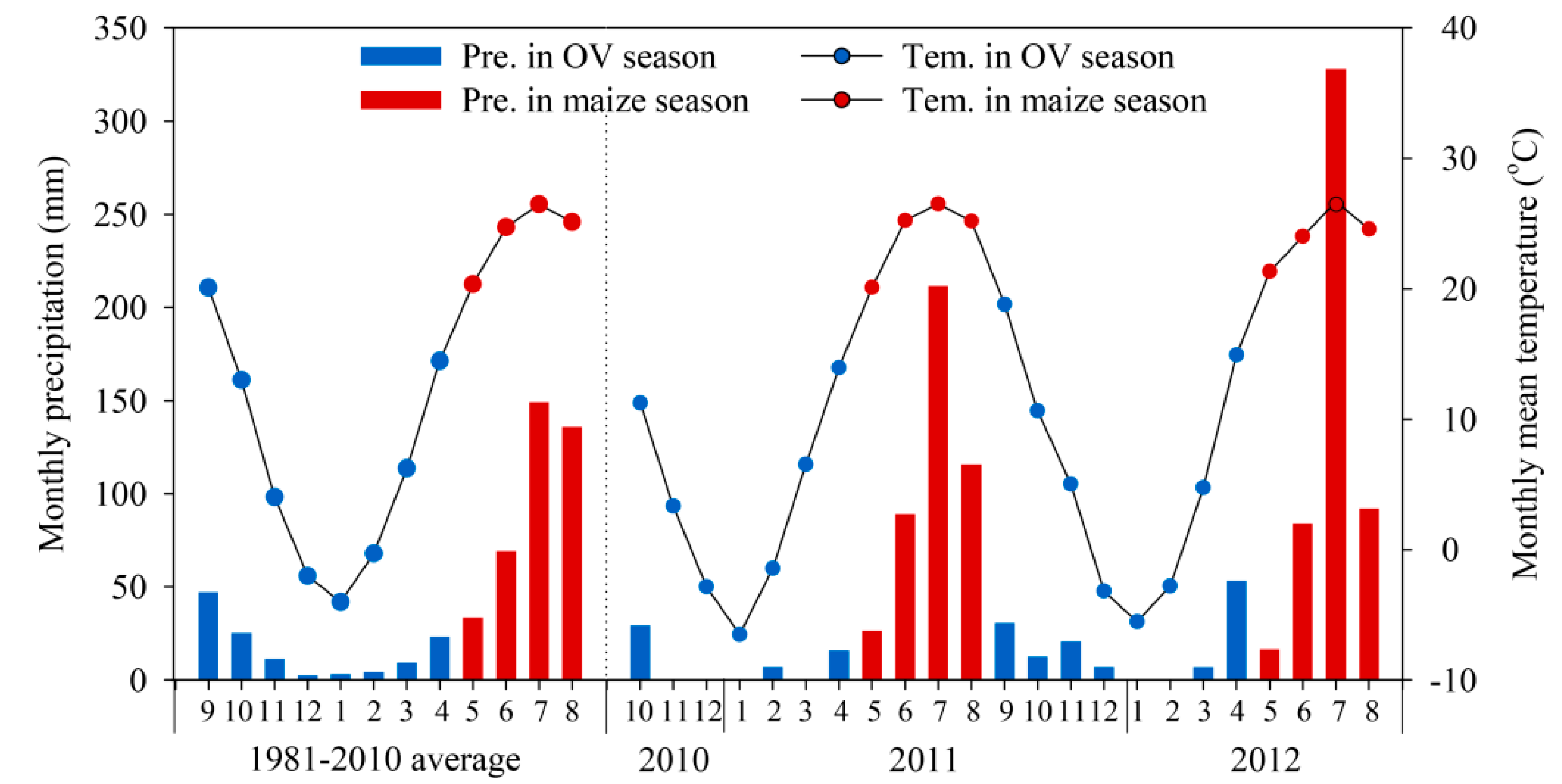
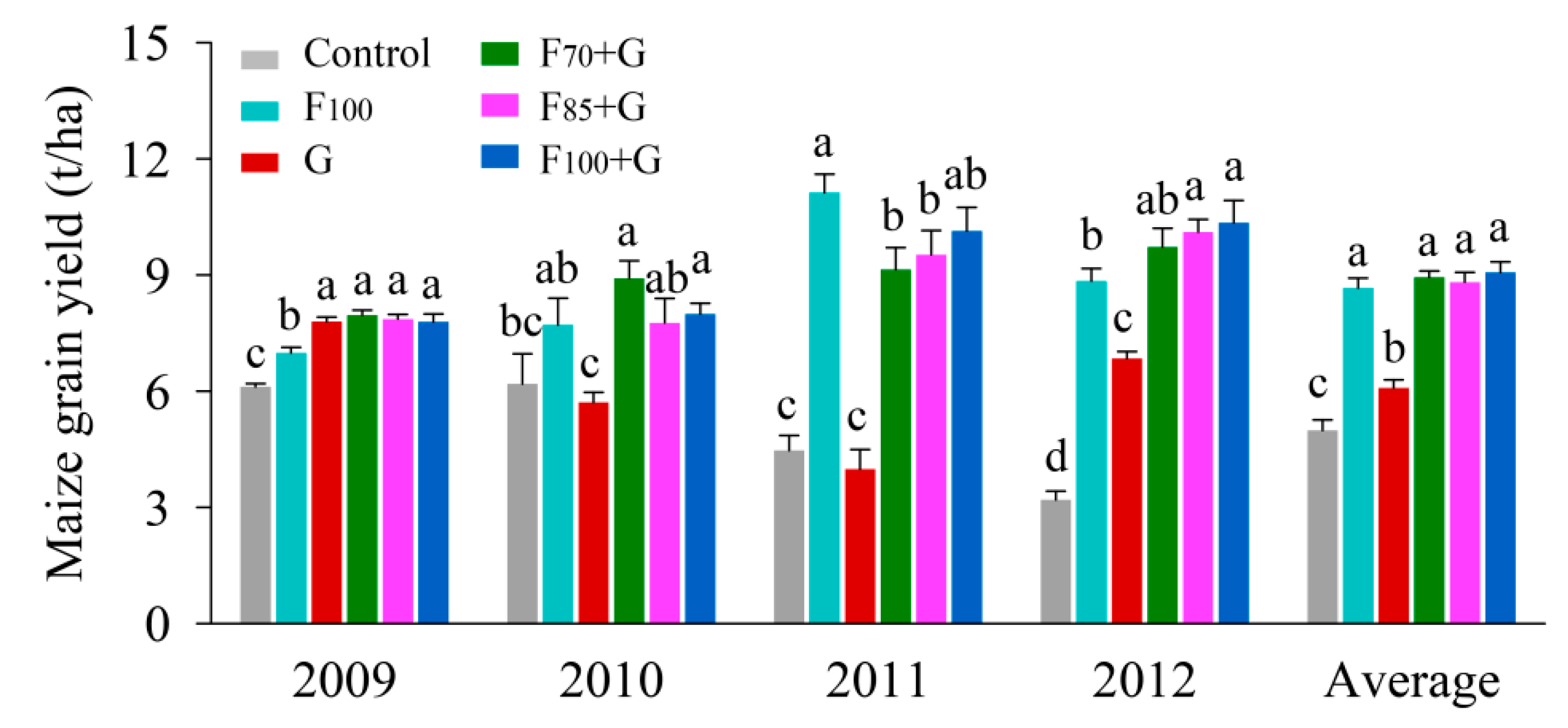
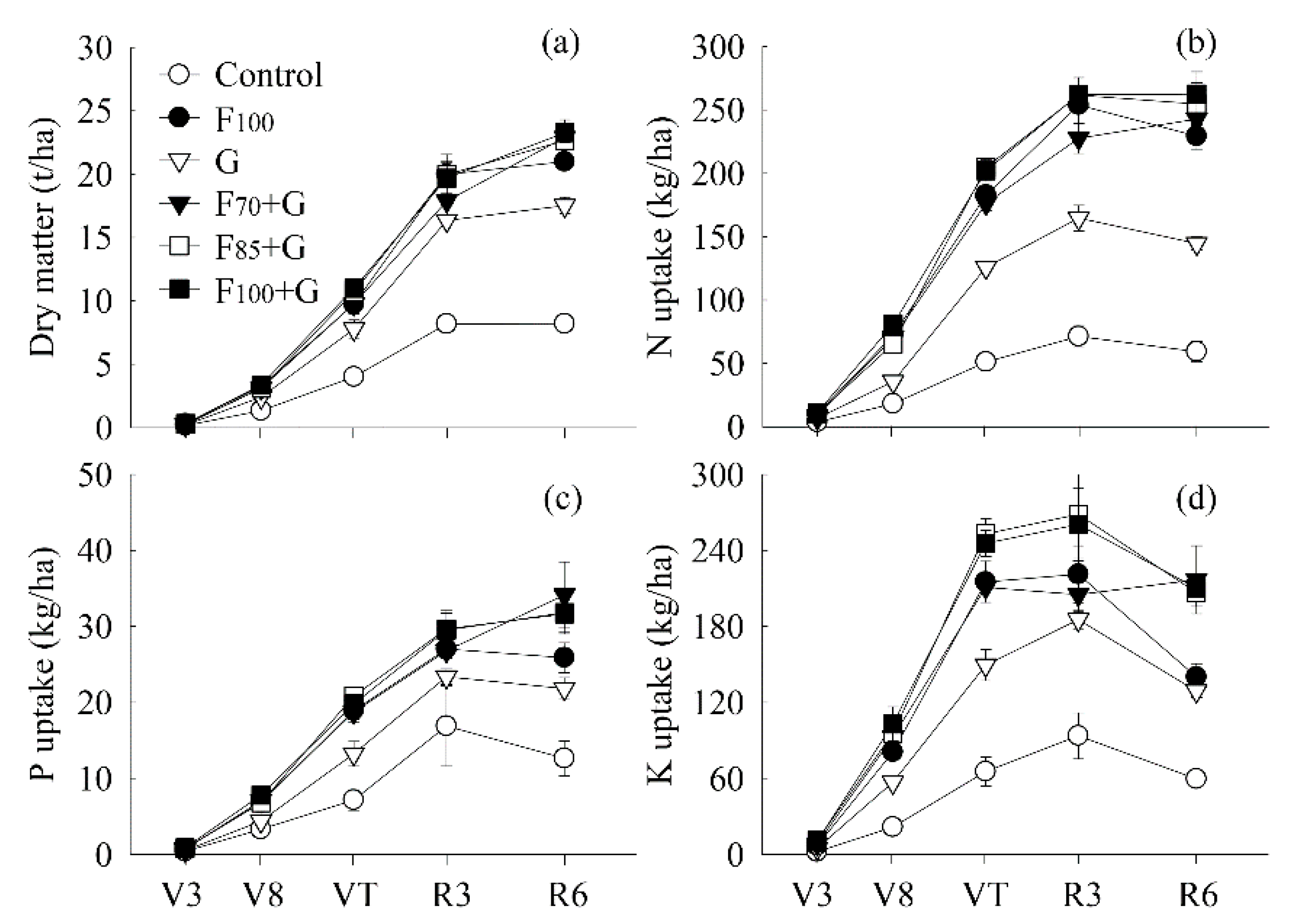
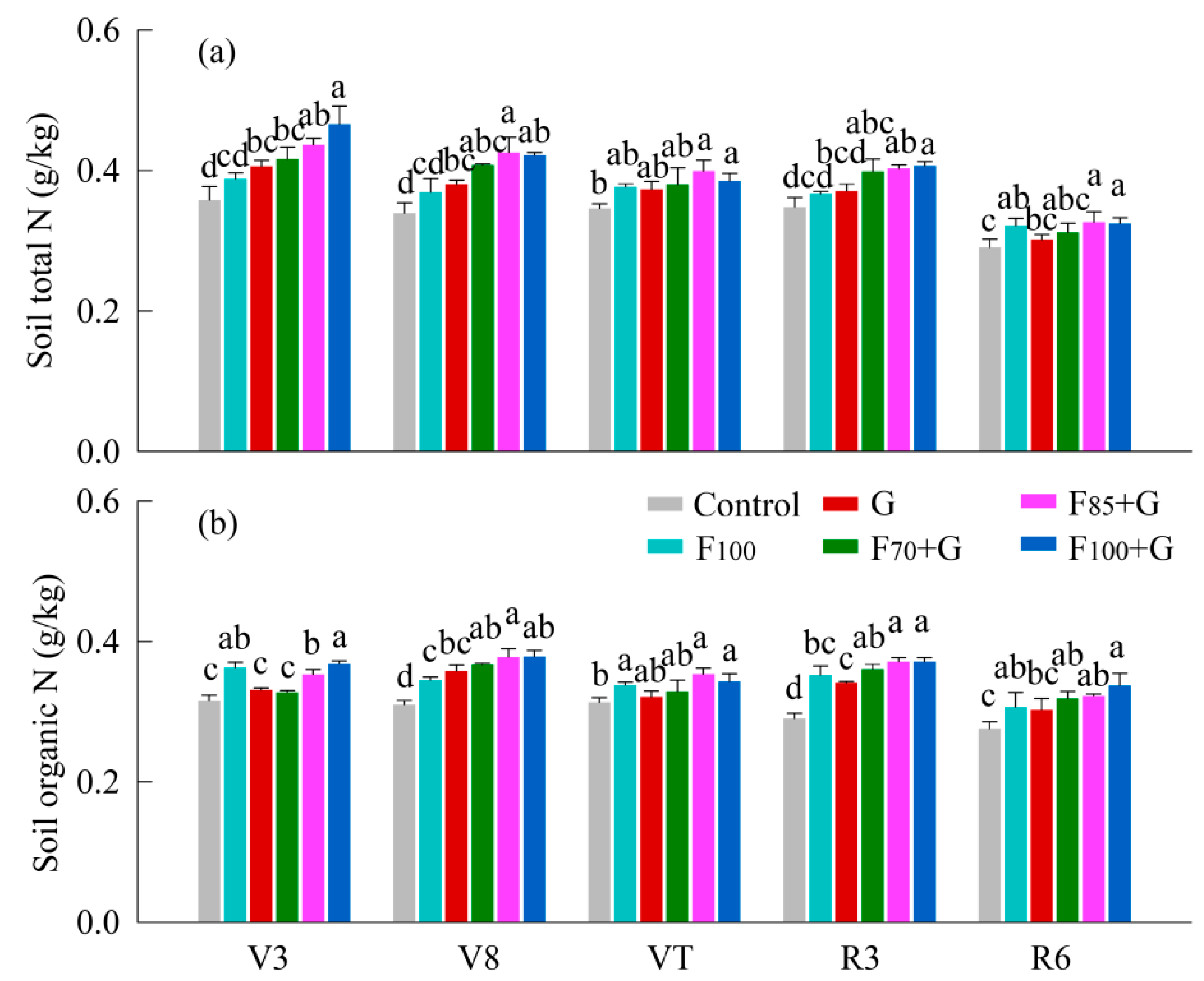
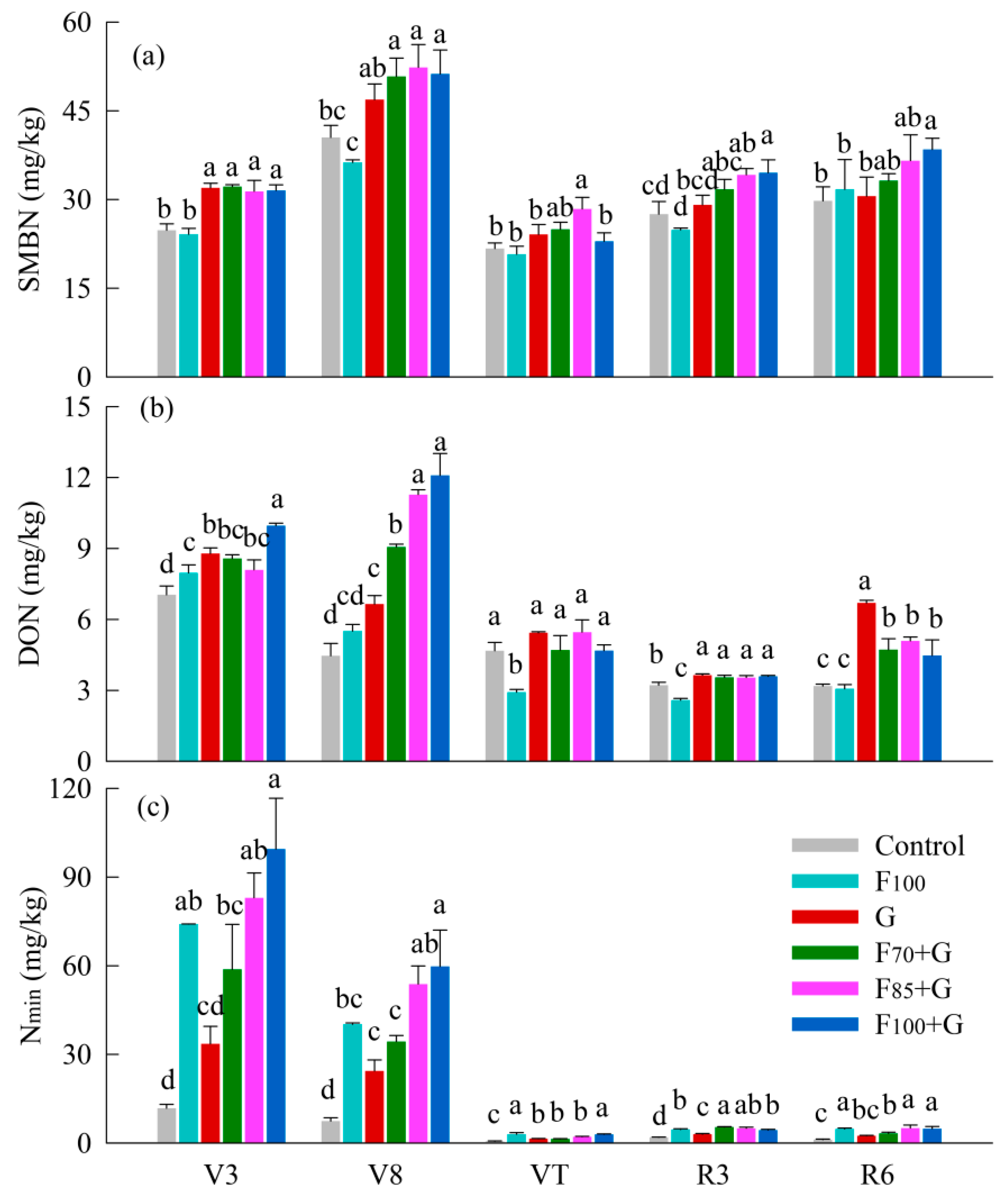
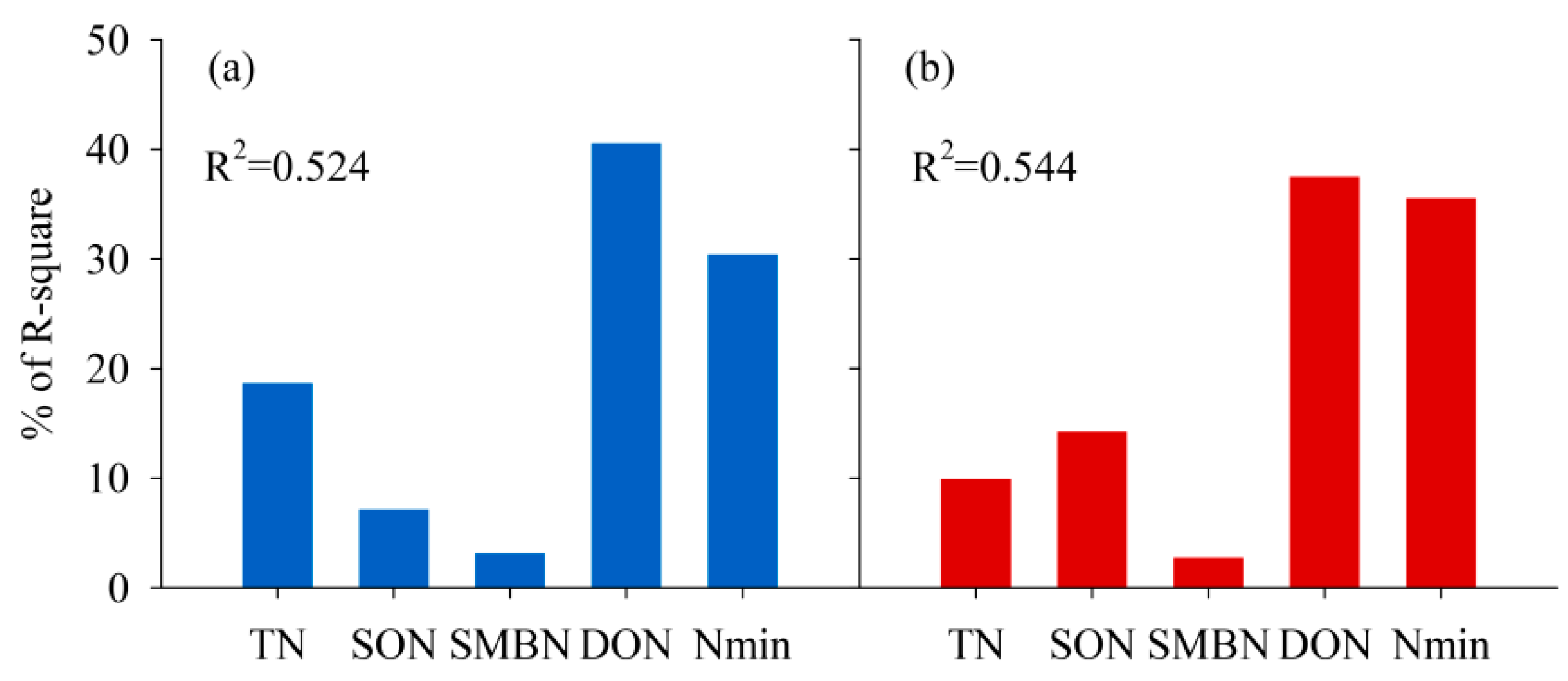
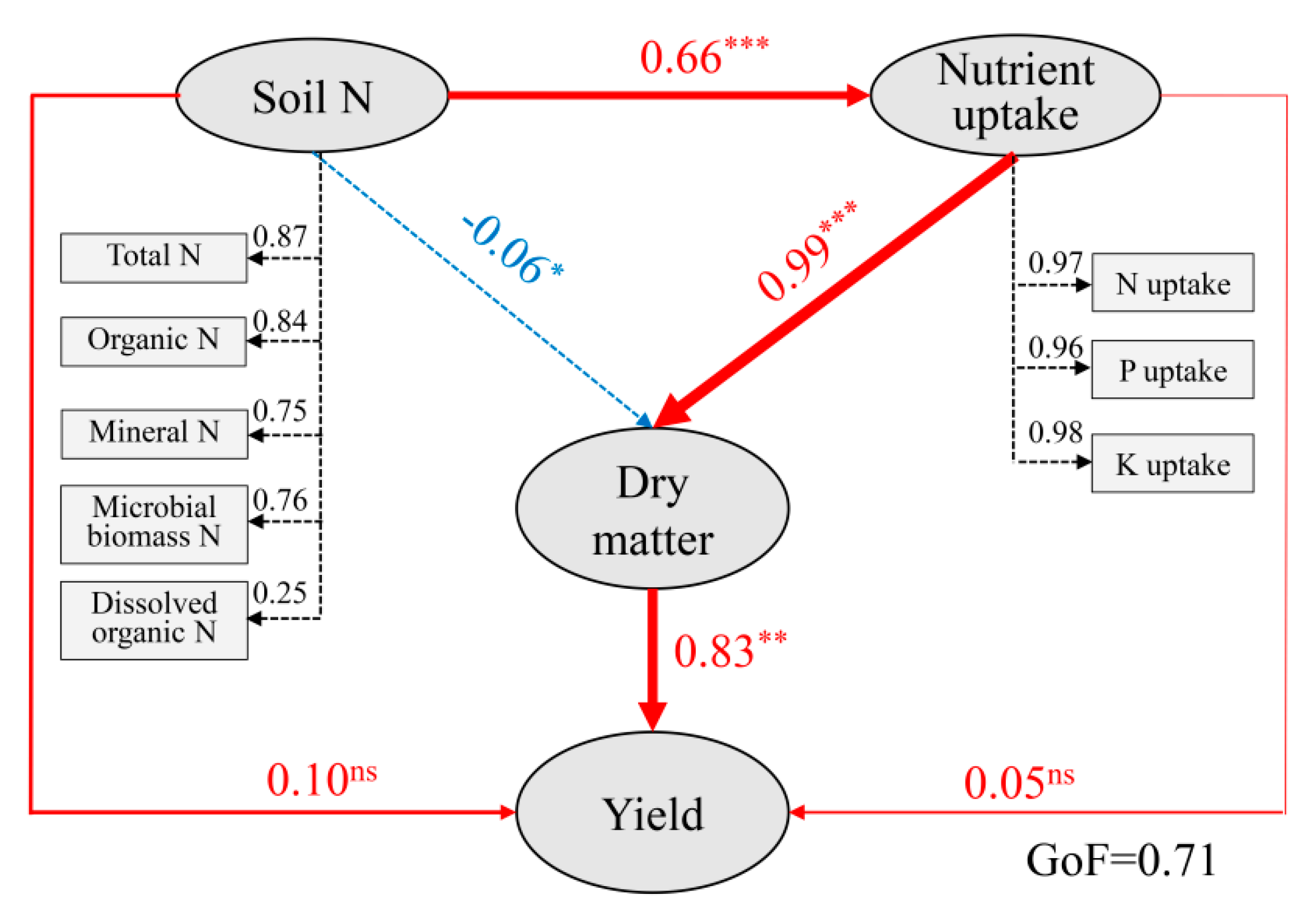
| Treatment | Cropping System | Input of Chemical Fertilizer Each Year (kg/ha) 1 | ||
|---|---|---|---|---|
| N | P | K | ||
| Control | Maize-winter fallow | 0 | 0 | 0 |
| F100 | Maize-winter fallow | 225 | 49 | 94 |
| G | Maize-green manure | 0 | 0 | 0 |
| F70 + G | Maize-green manure | 158 | 34 | 66 |
| F85 + G | Maize-green manure | 191 | 42 | 80 |
| F100 + G | Maize-green manure | 225 | 49 | 94 |
| Treatment | Incorporated Amount of Green Manure (Fresh Weight, t ha−1) 1 | Amount of Introduced Nutrient by Green Manure (N–P–K) (kg ha−1) | ||||||
|---|---|---|---|---|---|---|---|---|
| 2009 | 2010 | 2011 | 2012 | 2009 | 2010 | 2011 | 2012 | |
| Control | 0 | 0 | 0 | 0 | 0 | 0 | 0 | 0 |
| F100 | 0 | 0 | 0 | 0 | 0 | 0 | 0 | 0 |
| G | 15.6 | n.d. 2 | 4.6 | 22.5 (18.7) 3 | 52.6–9.6–77.4 | n.d. | 21.5–2.2–21.2 | 94.0–9.8–99.2 (78.5–8.2–82.7) 3 |
| F70 + G | 15.6 | n.d. | 10.2 | 22.5 (10.9) | 52.6–9.6–77.4 | n.d. | 48.0–4.8–47.0 | 94.0–9.8–99.2 (45.8–4.8–48.2) |
| F85 + G | 15.6 | n.d. | 19.0 | 22.5 (6.3) | 52.6–9.6–77.4 | n.d. | 89.8–9.0–87.9 | 94.0–9.8–99.2 (26.5–2.8–27.9) |
| F100 + G | 15.6 | n.d. | 15.2 | 22.5 (7.0) | 52.6–9.6–77.4 | n.d. | 71.5–7.2–70.0 | 94.0–9.8–99.2 (29.4–3.1–31.0) |
© 2018 by the authors. Licensee MDPI, Basel, Switzerland. This article is an open access article distributed under the terms and conditions of the Creative Commons Attribution (CC BY) license (http://creativecommons.org/licenses/by/4.0/).
Share and Cite
Yang, L.; Bai, J.; Liu, J.; Zeng, N.; Cao, W. Green Manuring Effect on Changes of Soil Nitrogen Fractions, Maize Growth, and Nutrient Uptake. Agronomy 2018, 8, 261. https://doi.org/10.3390/agronomy8110261
Yang L, Bai J, Liu J, Zeng N, Cao W. Green Manuring Effect on Changes of Soil Nitrogen Fractions, Maize Growth, and Nutrient Uptake. Agronomy. 2018; 8(11):261. https://doi.org/10.3390/agronomy8110261
Chicago/Turabian StyleYang, Lu, Jinshun Bai, Jia Liu, Naohua Zeng, and Weidong Cao. 2018. "Green Manuring Effect on Changes of Soil Nitrogen Fractions, Maize Growth, and Nutrient Uptake" Agronomy 8, no. 11: 261. https://doi.org/10.3390/agronomy8110261
APA StyleYang, L., Bai, J., Liu, J., Zeng, N., & Cao, W. (2018). Green Manuring Effect on Changes of Soil Nitrogen Fractions, Maize Growth, and Nutrient Uptake. Agronomy, 8(11), 261. https://doi.org/10.3390/agronomy8110261





